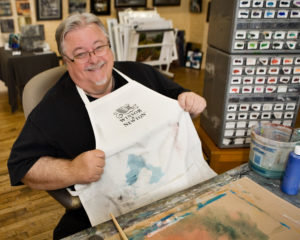By TESHA M. CHRISTENSEN
When 22-year-old Calvin deRuyter bought the Monitor in 1975 for $1 from a man who thought it had no future, he had no idea what he was getting himself into.
Forty-four years later he’s perfected the art of dealing with challenges in the job he’s loved.
“You face it, yell and scream at yourself and the world, then buck up and try to come up with a solution or solutions that will address the challenge,” stated deRuyter. “Isn’t that how we all face the challenges in life?”
Paper shares community identity
deRuyter had been the editor of his student newspaper, The Oracle, at Hamline University, and started working for the Highland Villager while he took a year off between his undergraduate and graduate work in art. He volunteered to edit the first issue of the “Midway ?”—which was given the name Midway Monitor following a neighborhood naming contest.
Some local business owners and leaders co-signed deRuyter’s first loan to get the paper started, and the Monitor joined the other community newspapers being birthed along with the neighborhood councils. Residents were seeking new ways to develop their community identity in the Cities. The first boundaries were established by the district council boundary, so the Midway Monitor followed the borders of the District 11 Hamline Midway Coalition.
“People were excited about being involved in their neighborhood and finally having, they believed, a way to have a voice in the shaping of city policy that was so prevalent in their lives,” recalled deRuyter. “The whole citizen participation movement was what shaped the paper for years. It was the same in Como when we expanded the paper to be the Midway Como Monitor.”
Nelson joins paper
Calvin deRuyter was one of the first people that Tim Nelson met when he enrolled at Hamline University. deRuyter was a junior and working as arts editor at The Oracle. They lived in the same dorm, and then worked together at the student newspaper. Nelson had been the editor of his high school newspaper, and set his sights on a career in politics and government. He had been accepted as a graduate student in Public Affairs at Willamette University in Oregon when deRuyter asked if Nelson was interested in working for him.
“I was intrigued, but torn as to what to do,” stated Nelson. “I called my advisor at Willamette and asked for his thoughts. His response surprised me. He said, ‘Tim, Willamette has been around since 1842, and I don’t think it is going anywhere. The chance to go into business for yourself may only come around once in a lifetime. Try the business, and if it doesn’t work out, you are welcome here. I look forward to hearing what you learn.’”
“I have never decided whether that was the best advice I ever got or the worst,” Nelson commented. “It varied day to day for the last 44 years.”
Nelson began as 50 percent partner in July 1977, and deRuyter-Nelson Publications was born. The expansion into the Como neighborhood occurred in 1979. The newspaper also expanded into the Frogtown area for a brief period but didn’t have the local ad revenue to support the growth.
The business was growing rapidly, and it was an exciting time.
“We started the typesetting business at that point, and it was an extremely fast-paced and technology-driven industry in those years,” stated Nelson. The newspaper did the typesetting for several college newspapers, including the Hamline Oracle and Bethel Clarion, as well as the Park Bugle, Equal Time, West 7th Community Reporter, Longfellow Messenger, and Grand Gazette.
People excited about paper
“The community was very excited about the paper in those days, and we had a constant flow of involved citizens coming to the office to share things of interest or suggest story ideas,” said Nelson. “Along with those people who believed in the paper, we also had groups we were less than popular with.”
A few bricks were thrown through the office windows at 600 N. Fairview (St. Paul) in response to endorsements of political candidates. During that same time, Nelson remembers when a columnist wrote an opinion piece that was critical of the organized church. “We had a religious group that went to our advertisers and told them that if they ran an ad, they would not support their business. We had many heated meetings with this group and it was not a pleasant time,” he said. “It was a rather contentious year! When the Job Corps moved into Bethel’s old St. Paul campus, we were also threatened by the community group who opposed that happening. They didn’t like how we were covering the events and again, threatened to go to advertisers with a boycott.”
Ironically, it is those same events that were not pleasant, such as vandalism and threats to their income base, that have also been the highlights.
“Any time a community is passionate about a topic, it’s an exciting time,” said Nelson. “Our goal is not to be loved by everyone. I have always considered the greatest compliment to be when we get complaints from both sides of a controversial issue saying that we are biased against them. That means we are providing a balanced story.”
Reach across the river
In 1986, deRuyter Nelson expanded its reach across the river into Minneapolis and purchased the Longfellow Messenger. Soon after the purchase, they expanded into the Nokomis East neighborhood.
The Messenger was formed in March 1983 by community activists Maureen and Bill Milbrath as a project for their retirement years. deRuyter-Nelson Publications had performed the typesetting for years, and they were the logical ones to purchase the paper. Plus, there was a family connection that they were not initially aware of. Bill had been a college fraternity mate of Nelson’s dad and was the soloist at his parents’ wedding.
Today, the Longfellow Nokomis Messenger has a circulation of 21,000 in the Longfellow and Nokomis areas of Minneapolis. It offers comprehensive home delivery to 17,000 homes and an additional circulation of 4,000 at high-traffic business, church, and school drop-off points. The Messenger has an estimated reach of over 50,000 readers.
The Monitor also has an estimated reach of over 50,000 residents in St. Paul’s Midway, Como, and Merriam Park neighborhoods. With a circulation of 21,000, the Monitor offers comprehensive delivery to 16,000 homes and businesses and an additional circulation of 5,000 at high-traffic business, church, and school drop-off points.
Over the years, deRuyter-Nelson also operated a successful graphic design business, providing design and production services to large and small corporations and government agencies. Out of personal tragedy, they created A Place to Remember, a business that published and distributed resources worldwide for families experiencing a difficult pregnancy, premature birth, or death of an infant. A Place to Remember is closing after 25 years as deRuyter and Nelson retire.
The Monitor and Messenger gave up the longtime Iris Park Place office in St. Paul four years ago, and have operated with a virtual office since then. Other shifts at the time involved Nelson handling the newspaper production and deRuyter the editor responsibilities once again, while long-time editor and sales representative Denis Woulfe began focusing only on sales.
Evolving industry
The industry is changing, but deRuyter and Nelson still believe newspapers are part of the fabric of neighborhoods.
“I think community newspapers are vital to the neighborhoods,” observed deRuyter. “We have watched so many community newspapers die so that the community journalism movement in the Cities is just a tiny fraction of what it used to be. I don’t think there is a single community that is better off because their community newspaper could not survive.”
“But I also think that the residents and the businesses don’t truly grasp the importance of the cohesiveness that the neighborhood press provides,” deRuyter added. “If it is used properly, the community newspaper can be the place where things ‘come together’ in one place; where you can get an overview of the things going on; where you can learn about the unique businesses that are housed there; where you can learn about the neighbor who has faced a challenge, or who has overcome one.”
deRuyter asked, “Where is that place if your community newspaper dies? You certainly won’t get it from the city-wide or regional press.”
Nelson has also mulled over the changing face of journalism over the past four decades that he’s been involved in it.
“I think that over the years, the papers lost some of the fire that made them more interesting in the early days. The stories became more routine, and there is no way the timeliness of a monthly publication can compete with the immediacy of news spreading on social media chat groups or blogs. The need for a community newspaper in a neighborhood was diluted.”
But, Nelson quickly added, “That is not to say that I don’t think that there is a need for a community newspaper or that the concept is dead. As a matter of fact, it may be more important now than ever given the fact that the daily papers are struggling to find their niche and are cutting budgets to compete in the electronic age. Social media does not even attempt to be objective, and although the media is constantly being accused of bias, I assure you we always attempt to bring the community both sides of an issue. It’s a matter of finding out what readers want to learn more about from their neighbors, and working to help reshape that delivery.”
What’s next?
Nelson and deRuyter will officially retire on May 1, 2019, when they pass ownership of the Messenger and Monitor to Tesha M. Christensen, who has been a deRuyter-Nelson freelance writer for the past eight years and has worked in journalism for over 20 years.
What’s next for these longtime news hounds?
 After balancing his newspaper business with the artwork that he picked back up 18 years ago, deRuyter (photo right) plans to focus on his art business (www.calsportfolio.net). In addition to painting, he offers various classes and workshops. He and his husband, Jim, are also renovating an old schoolhouse outside of Evansville, MN. He’s not leaving the Monitor or Messenger completely, either, as he’ll be providing bookkeeping services to the new owner.
After balancing his newspaper business with the artwork that he picked back up 18 years ago, deRuyter (photo right) plans to focus on his art business (www.calsportfolio.net). In addition to painting, he offers various classes and workshops. He and his husband, Jim, are also renovating an old schoolhouse outside of Evansville, MN. He’s not leaving the Monitor or Messenger completely, either, as he’ll be providing bookkeeping services to the new owner.
Nelson will continue selling a support book he wrote for fathers who have experienced the death of an infant through miscarriage, stillbirth, or early infant death. The book, “A Guide For Fathers–When A Baby Dies,” is in its seventh printing.
 Also, Nelson (photo left) and his wife, Monica, have four children living around the world. “It’s not always ideal having your children spread out, but at least they have chosen interesting places to visit—London, El Nido (Philippines), Phoenix and Los Angeles,” remarked Nelson. They are also fortunate to have six grandchildren living in Arizona and are anxiously awaiting the arrival of triplet girls in California.
Also, Nelson (photo left) and his wife, Monica, have four children living around the world. “It’s not always ideal having your children spread out, but at least they have chosen interesting places to visit—London, El Nido (Philippines), Phoenix and Los Angeles,” remarked Nelson. They are also fortunate to have six grandchildren living in Arizona and are anxiously awaiting the arrival of triplet girls in California.
“Let’s just say, I’m not worried about being bored,” said Nelson. “At least while I am still able to get on a plane.”
Comments
No comments on this item Please log in to comment by clicking here